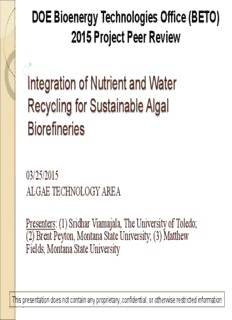
Integration of Nutrient and Water Recycling for Sustainable Algal PDF
Preview Integration of Nutrient and Water Recycling for Sustainable Algal
DOE Bioenergy Technologies Office (BETO) 2015 Project Peer Review Integration of Nutrient and Water Recycling for Sustainable Algal Biorefineries 03/25/2015 ALGAE TECHNOLOGY AREA Presenters: (1) Sridhar Viamajala, The University of Toledo; (2) Brent Peyton, Montana State University; (3) Matthew Fields, Montana State University This presentation does not contain any proprietary, confidential, or otherwise restricted information Goal Statement Develop the science and engineering for sustainable biomass production through use of: o Wastewater and nutrients recycled from N- and P-rich post- conversion residues. o Minimizes inputs of water and synthetic fertilizers. o High lipid-producing native alkaliphilic algae. o Cultures tolerant to high pH may outcompete unwanted algae in these harsh environments. o Alkaline solutions result in higher flux of ambient inorganic carbon for lipid production. o Significant savings accomplished by eliminating capital and energy costs associated with CO distribution. 2 o Stimuli-sensitive hydrogel methods for harvesting and water recovery for reuse. o No use of contaminating chemicals (e.g. flocculants). 2 Quad Chart Overview Timeline Barriers Project start : 2/1/2013 Barriers addressed Project end : 12/31/15 o Al-B. Algal Fuel Production Percent complete: 66% o Feedstock development and nutrient supply o Harvest - Dewatering and water recycle Budget Partners The University of Toledo – Lead Total FY 13 FY 14 Total (44%) Costs Costs Costs Planned FY 10 – Funding(FY Montana State University (44%) FY 12 15-Project End Date University of North Carolina (12%) DOE n/a $868,860 $861,717 $1,269,357 AlgEvolve, Inc. Funded Environmental Department, Logan Project n/a $201,377 $213,137 $335,579 City, Utah Cost Share (Comp.)* 3 Project Overview CO-PRODUCTS FROM RESIDUE Recycle Nutrients Nutrient recovery from residues Feedstock Feedstock Feedstock Cultivation Harvesting Conversion Makeup Pyrolysis Nutrients Primary Alkaliphilic OR (fertilizer dewatering Secondary algal FUELS & or waste) -Smart dewatering In situ trans- cultures PRODUCTS hydrogels esterification OR Solvent Makeup Extraction Water Recycle Water PROJECT OBJECTIVES: Evaluate the effects of nutrient integration/recycle options on algae growth and lipid production. Develop low-cost water-recovery methods. Characterize the development, structure, and stability of microbial communities in algal systems. Perform economic and life cycle assessments (LCA) for sustainable algal biorefineries. 4 Approach Assess biomass productivity and nutrient utilization during growth on (1) wastewater and (2) nutrients recovered from post-conversion residues. A.1.GN.1 and A.1.ML.1 : 20 g/m2/d and 0.1% - Productivity and yield using wastewater (12/31/2014); A.2.ML.1 : 20 g/m2/d and 0.1% - Productivity and yield using recycled nutrients (12/31/2015). Develop stimuli-responsive hydrogel-based techniques for recovering water and unused soluble nutrients. B.2.ML.1 : 2% (20 g/L) biomass concentrations achieved after hydrogel dewatering (12/31/2015) Characterize bacterial and algal communities in lipid-producing alkaliphilic cultures grown in wastewater and on recycled nutrients. C.3.ML.1 : At least one stable community characterized in wastewater and with recycled nutrients (12/31/2015). Assess economic and environmental impacts of the nutrient and water management alternatives using mass and energy balance data obtained from laboratory studies. D.2.ML.1 : LCA model for integrated growth system (12/31/2015). Perform pilot scale growth on municipal wastewater with most productive and stable alkaliphilic strains. D.2.ML.1 : Demonstration of algal growth at pilot scale (2000L) (12/31/2015). 5 Task A: Evaluation of nutrient recycling and integration options for algae growth Subtasks: A.1 – Algae cultivation by nutrient integration with wastewater sources (2/1/13 to 12/31/14) A.2 – Algae cultivation by nutrient recycling from post- conversion residues (1/1/2015 to 12/31/2015) ◦ Post extraction residues ◦ Thermochemical residues Milestones: 20 g/m2/day and 0.1% (1g/L) productivity and yield using wastewater (12/31/2014) 20 g/m2/day and 0.1% (1g/L) productivity and yield using recycled nutrients (12/31/2015) 6 Alkaliphilic algae Context These alkaliphilic strains show high lipid productivity in well-defined media. High pH growth environments (i) increase driving force for CO dissolution and achieve 2 higher dissolved inorganic carbon concentrations, (ii) provide means of using low quality alkaline/saline water and (iii) may allow alkaliphilic algae to outcompete unwanted algae. Fatty acid profile is conducive for fuel production. Fatty acid profile Strain Organism FAME yield (w/w) WC-1 Scenedesmus sp. 26% RGd-1 Diatom 46% SLA-04 Chlorella sp. 42% 7 Bicarbonate as an inorganic carbon substrate Algal biofuel farms can use carbon dioxide captured from flue gas May not be economically practical due to Cost associated with transport and storage of CO 2 Low mass transfer efficiency (loss of CO back into atmosphere) 2 Bicarbonate can be produced by sorbing CO in alkaline solutions 2 (e.g. Na CO ) 2 3 Na CO + CO + H O 2 NaHCO 2 3 2 2 3 Solutions (and solids) can be readily transported, stored or regenerated “Bicarbonate trigger” Addition of HCO - induces 3 predictable TAG accumulation. Scenedesmus sp. WC-1 Confirmed on over 20 Chlorophyte and diatom strains – freshwater and marine. ◦ However, bicarb trigger does not always work ◦ more fundamental work to be done Gardner R, et al. 2012. Journal of Applied Phycology. 24(5): 1311-1320 Gardner R, et al. 2013. Biotechnology and Bioengineering 110(1): 87-96 9 Laboratory-scale cultivation on municipal wastewater (MWW) Strain WC-1 Growth in PC Effluent Experiments were focused on growth in primary clarifier effluent WC-1 growth very similar between generations ◦ Reached stationary growth ~6 days after inoculation ◦ No additions (N, P etc.) necessary
Description: